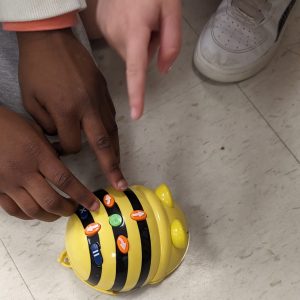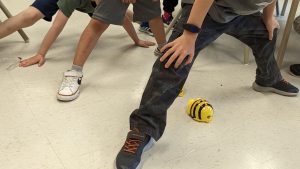Using technology with students is not always in my comfort zone but that didn’t stop me from trying out bee-bots with kindergarten students. A bee-bot is a type of programmable floor robot designed for children ages 4-7. I wanted to see what would happen if we followed the kindergarten model of exploration and play as a way to guide a coding inquiry with bee-bots. Here’s what I discovered.
As you can imagine when I brought 12 bee-bots into a kindergarten classroom for the first time there were squeals of excitement. We sat in a circle to have a lesson on how the directional buttons controlled its movement and the green GO button would get it started. Then we cleared the programming by using the X button and started over again.
Students worked with a partner, taking turns programming a bee-bot to see where it would travel. They seemed most happy when bee-bots unexpectedly went under chairs or bumped into a shelf or wall. Getting a bee bot to spin around repeatedly was a favourite activity of one group and another group was determined to get just the right number of commands to make the bee-bot cross the classroom.
As a prep time coverage teacher, I visit kindergarten weekly with a cart of learning tools. The cart has a variety of materials to cater to different learning styles and I refresh it with new items often. The bee-bots had been on the cart for a while and interest was waning so I got out the bee-bot maps and the covers that look like stormtrooper helmets. These new items have refreshed interest in the bee-bots as students can program the robots to find treasure on the island map or go shopping on the town map.
One challenge the students tried was to program the bee-bots to have coordinated movements so they look like they are dancing. Another challenge was to have the bee-bot knock down a small tower of blocks. I noticed students were engaging in dramatic play with the bee-bots taking on the roles in stories they were creating so we tried programming the bee-bots to retell a familiar story, Goldilocks and the Three Bears.
In another class, the students noticed the bee-bots had a little hook on the back so they invented trailers to test the bee-bots’ strength. Then they tried to hook the bee-bots together so that one was dragging another around . They created a human tunnel using their friends’ legs to see if the bee-bots could make it through.
As a group we used the website https://beebot.terrapinlogo.com/ and tried out different maps. This allowed me to review directionality and the way that coding sequences are recorded in the bee-bots.
All in all I’d say the bee-bots have been very successful in kindergarten and that the students have created many more ways to play and learn with these tools than the very straightforward coding lessons I was thinking we would do.
As with most trial and error attempts in my career I learn alongside the students. I would definitely use the bee-bots again and allow students the opportunity to explore and play with the concepts of coding.


